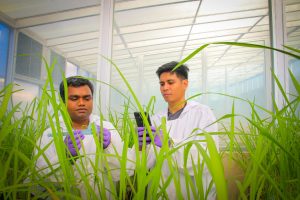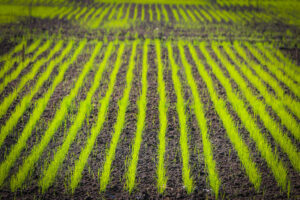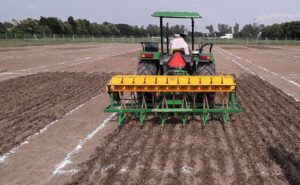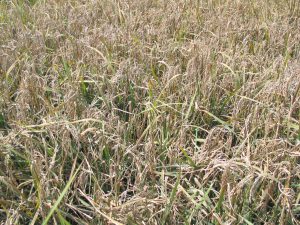Ask someone to think of a rice field and odds are they’ll imagine a flooded paddy. Growing rice in puddled fields works well as long as there’s enough water to do it. But, increasingly, that’s not always the case. As populations increase and the industrial and urban sectors compete with agriculture for water, “aerobic rice” offers a water-saving alternative to many of the millions of rice farmers worldwide.
Aerobic rice is a production system in which specially developed varieties are grown in well-drained, nonpuddled, and nonsaturated soils. With appropriate management, the system aims for yields of at least 4–6 tons per hectare.
The usual establishment method is dry direct seeding, as opposed to transplanting seedlings into a flooded field. Aerobic rice can be rainfed or irrigated. Irrigation can be applied through flash-flooding, in furrows (or raised beds), or by sprinklers. Unlike flooded rice, irrigation—when applied—is not used to flood the soil but to just bring the soil water content in the root zone up to field capacity (the maximum possible before saturation occurs).
Aerobic rice also allows farmers to practice conservation agriculture, such as mulching and minimum tillage. Despite these advantages, farmers must overcome several problems that are affecting arobic rice. Rice fields that are not permanently flooded tend to experience more weed growth and more species of weeds. Appropriate herbicide use, plus additional manual or mechanical weeding in the early phases of crop growth, is therefore needed to control weeds.
Soil-borne pests and diseases such as nematodes, root aphids, and fungi are known to occur more in aerobic rice than in flooded rice, especially in the tropics. Currently, aerobic rice cannot be grown continuously on the same piece of land each year without a yield decline. Depending on the cropping history and soil type, low yields can even occur on fields cropped to aerobic rice the very first time.
Achieving high yields under relatively favorable aerobic soil conditions requires new varieties of aerobic rice that combine the drought-resistant characteristics of upland varieties (grown on nonflooded sloping uplands) with the high-yielding characteristics of lowland varieties (grown in irrigated, flooded fields). Several breeding projects, such as the ongoing program at the International Rice Research Institute, are working toward this goal.
First-generation tropical aerobic rice varieties were mostly derived from crosses between tropical parents from the two major subspecies of rice, indica and japonica. Some aerobic rice breeding programs have also developed successful varieties by crossing high-yielding lowland rice varieties with traditional upland types. In northern China, several new elite aerobic varieties with yield potential of up to 6.5 tons per hectare were released in the late 1990s.
Aerobic rice can be found, or can be a suitable technology, in the following areas:
1. So-called “favorable uplands”: areas where the land is flat (or terraced), where rainfall with or without supplemental irrigation is sufficient to frequently bring the soil water content close to field capacity, where no serious soilchemical limitations occur, and where farmers have access to external inputs such as fertilizers. Examples include the Cerrado region of Brazil and newlyformed terraces in the hills of Yunnan, China, where farmers are achieving aerobic rice yields of 3–4 tons per hectare.
2. Fields on upper slopes or terraces in undulating, rainfed lowlands. Quite often, soils in these areas are relatively coarse-textured and well-drained, so that ponding of water occurs briefly or not at all during the growing season. There are no widespread examples of aerobic rice in rainfed lowlands, but these upper fields have been proposed as a target domain.
3. Water-short irrigated lowlands: areas where farmers do not have access to water to keep rice fields flooded for a substantial period of time. A good example is the North China Plain, where aerobic rice is grown on about 80,000 hectares with supplemental irrigation.
Besides these typical rice-growing environments, aerobic rice can also be found in traditionally nonricegrowing areas. Again in the North China Plain, farmers are experimenting with aerobic rice as a means of crop diversification in areas where maize has traditionally been the dominant crop.
Will aerobic rice replace rice grown in flooded conditions on a large scale? It may be too early to tell, but there is no doubt that, as rice farmers are forced to compete for less and less available water, aerobic rice has a major role to play.
_________________________________________
Dr. Bouman is a senior water scientist at IRRI.










